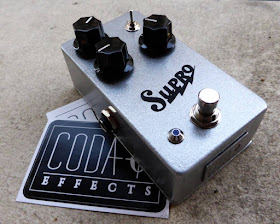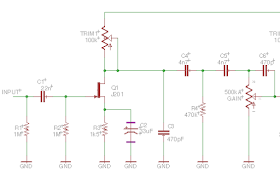This is a JHS Superbolt clone! JHS is not one of the most honest builders on the planet, and he is known for his ability to steal circuit designs from other builders. The Superbolt is no exception, and is in fact a really slightly modded Run Off Groove Supreaux. Runoffgroove is a community creating circuits for DIY people, and making it public through Creative Common license. There are many nice circuits there, take a look! JHS did not bother with the license and just copy it and started to sell it.

I decided to make a clone, mainly because some videos on the web of the Superbolt were really good sounding. I used a prepainted grey enclosure from Banzai Music, and the "Supro logo" was laser cut by HPM Laser.
The pedal has 3 knobs: gain, which acts like the volume of a class A amp: the higher it is, the higher the volume and the saturation. The volume knob acts as a master volume; the tone knob add or remove bass and treble (slightly). There is a two positions switch that allow you to switch between a gainy bassy position, and a slightly less gainy with more treble position.


It is a bit messy inside, but not that much for a veroboard with 3 pots layout. At first I was planning to have space for a battery, but the input jacks were too big for that... So 9V power supply only! Adjusting the 3 trimpots was quite easy. I started with 9V on the emitter of each transistor, but this was too gainy in my opinion, so I diminished it (except for the last transistor). The pedal is thus less gainy.

Circuit analysis
Here is the schematic of the ROG Supreaux:
And here is the JHS Superbolt schematic:
You can see that it is basically the same circuit, with an added voltage doubler (top part of the circuit), and a switch adding a 120k resistor connected to the ground before Q3.
Lets divide it in several sections as usual:
You can see that it looks a lot like an amplifier! It is really inspired by an amplifier schematic, except that tubes are replaced with JFET transistors. Which is really appropriate because JFET transistors (Junction Field Effect Transistors) use a technology that is really close to tubes, and they sound quite "tube-like" when saturating: warm, creamy overdrive compared to the aggressive gritty saturation of silicon transistors.
All the saturation of this circuit is based on the saturation of these transistors: you can see that there are no diodes in the circuit. It is different from what we are used to with the Big Muff or the Jan Ray (Timmy).
To sum up, it works like this: the first preamp section amplifies the signal, and will drive the second transistor. The saturated signal will be slightly modified in tone by the tone stack section, and a third transistor will set up the final volume. Like I said, it really works like an amplifier!
Let's see every part of the circuit in detail.
Power supply section

A MAX1044 IC is then used to double the voltage, in order to have an 18 volts bus that will be provided to the JFET transistors. Having 18 volts instead of 9 gives a bit more headroom and clarity to the circuit, and this had been used in the Supreaux Deux version of the circuit. It uses the example circuit that you can find in the datasheet:

Preamp section 1: gain

The signal is amplified by the first transistor (Q1). You can see that the overall gain of the transistor can be adjusted with a 100k trimpot that will adjust the DC current on the drain of the transistor. That way, you can set what the maximum gain of the pedal will be. The maximum possible gain is set also by the resistor R3 (1k5).
Then, the signal is filtered a bit by different means: a 470 pF capacitor connected to ground let high frequencies going to ground, thus eliminating a bit of high frequencies. To eliminate more high frequencies, value of this capacitor can be changed to a bigger value like 560 pF for instance. A 470K resistor connected to ground will set the bass response of the unit, and will eliminate a bit of bass. A potentiometer wired as a variable resistor will then set how much signal will go to ground. Thus, it defines how much the signal is amplified, and how much signal will drive the second transistor: it is the gain potentiometer!
Preamp section 2: tonestack

The amplified signal of the first section will then make the second transistor (Q2) saturate. The amplification of Q2 is also set by a 100k trimpot and R5 (2k7 resistor), and can be modulate to have more or less saturation.
There is a 10 nF coupling cap to eliminate parasitic DC current remaining from the 18V bus, and then the signal is modified by the tone potentiometer. It is wired as a variable resistor connected to ground, and will eliminate more or less bass frequencies. An optional switch also allows you to connect a 120k resistor to ground, which will diminish overall gain (a part of the signal will go to ground), and bass response (more bass will go to ground than high frequencies with a 120k resistor). This allows you to simulate the two High and Low inputs of the Supro amplifiers.
Again, a 470K set the maximum gain of this part of the circuit.
Amplifier: master volume section

Final volume is set by a potentiometer wired as a variable resistor connected to ground, like we have already seen in many many circuit, like the Fuzz Face for instance. The higher the value of this resistor will be, the less signal will go to ground and the bigger the output signal will be: more volume!
Here it is!
I hope that everything is clear, do not hesitate to ask question if some stuff is still unclear by posting a comment!
Did you like this article? Like the Coda Effects Facebook page!
To go further:
Runoffgroove Supreaux webpage
Runoffgroove Supreaux Deux webpage
MAX1044 datasheet.



This comment has been removed by the author.
ReplyDeleteLove this build! Could I pay you to build one for me?
ReplyDeleteThank you !
DeleteI am planning on opening a small "shop" section soon. This build will surely be in it. If you send me an email, I can contact you when it will be online.
Benoit
Thanks so much for taking the time to write about all this, it's extremely helpful. And great job building the pedals, they look amazing!
ReplyDeleteI have built this circuit and no matter what i do it cuts too much bass. Which cap or resistor should I change. C4, C5, C6, and C9 seem to add a little bass back in when i increase them and look at it on a scope but I wanted to get your opinion considering the fact that you may have experience with this issue possibly.
ReplyDeleteHello ! I agree that there is not too much bass with this circuit. Actually, I find it a bit too bright for my ears. I never tried it, but I think that you can try to change the high pass filter formed by the tone pot and C8. Increasing C8 to 10 or 22nF would be a good starting point I think.
DeleteHi! I built a Superbolt clone following the schematic but when I turn on the pedal it sounds very quiet, with a 30W Valvetronix amp with the master at full and the volume at full too it sounds quiet than 10w amp with the volume at 7 maybe... When the switch is turned to the bass position it turns more quiet. I revised the biasing but any suggestion is accepted. I think it could be a defective transistor or something related with them, I ordered a newer pair, I would be so pleased if you can help me! Thanks!!
ReplyDeletethis might be a silly question, but I cant for the life of me figure out the cap values for the two caps after the voltage doubling IC (C14 and C15). Could you let me know what those are? Thanks!
ReplyDeleteHello,
DeleteThey are 10uF electrolytic capacitors
Benoit
Hi there Benoit, thank you for all that you do! I was wondering if all the capacitors are getting hit with 18v or just some of them? I'm new to all of this. My 100u and 33u are only rated for 16v, but I'm not sure if they're getting 9 or 18v. Thanks!
ReplyDeleteC12 and C13 are only 9V, however, for most of the other capacitors, there are chances that they get through more than 16V... Therefore, except for C12 and C13, I would recommend to use 25V rated capacitors.
DeleteThanks so much!
Deletethank you so much for the in depth article! can you tell me how you set the 100k trim pots for each stage? are you just tweaking until you hear max gain?
ReplyDeleteSo let me get this straight: you open this post by bashing Josh Scott (who you've probably never actually talked to about these tired rehashed allegations, which are a complete double standard in the first place), and then you proceed to show off how you've literally violated Absara Audio's copyright on the registered Supro brand? Hmmm... sounds about right from the "I hate JHS" crowd.
ReplyDeleteThank you for another great post. Where else could anybody get that type of info in such a perfect way of writing? I have a presentation next week, and I am on the look for such information. https://royalcbd.com/product/cbd-salve/
ReplyDelete